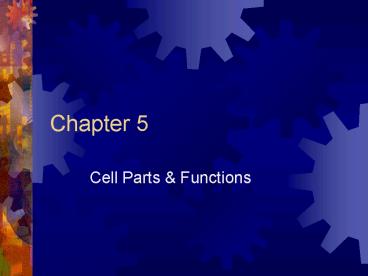Cell Parts - PowerPoint PPT Presentation
1 / 38
Title:
Cell Parts
Description:
Compare the structure, function, and interrelatedness of cell organelles ... are composed of cells ... Composed of RNA and protein. Very small in size ... – PowerPoint PPT presentation
Number of Views:20
Avg rating:3.0/5.0
Title: Cell Parts
1
Chapter 5
- Cell Parts Functions
2
OGT Standards
- Explain that living cells are the basis of life
- Compare the structure, function, and
interrelatedness of cell organelles in eukaryotic
cells
3
5-1 The Cell Theory
- Objectives
- Become familiar with scientists that made
discoveries in cells - Know the cell theory
4
5-1 The Cell Theory
- 1600s
- Anton van Leeuwenhoek developed 1st microscope
saw small organisms in water - Robert Hooke used microscope and was the 1st to
call cells cells looked at thin slices of
wood, cork, etc.
5
- 1833 - Robert Brown found dark structure near
center of the cell nucleus - 1838 Matthias Schleiden all plants are made
of cells - 1839 Theodor Schwann all animals are made of
cells - 1855 Rudolf Virchow all cells arise from
preexisting cells
6
The Cell Theory (MUST KNOW)
- All living things are composed of cells
- Cells are the basic units of structure and
function in living things - All cells come from preexisting cells
7
5-2 Cell Structure
- Objectives
- Identify and give function of three basic cell
structures - Distinguish between prokaryotic and eukaryotic
cells
8
5-2 Cell Structure
- 3 basic structures found in most cells (MUST
KNOW) - Cell membrane
- Nucleus
- Cytoplasm
9
Cell membrane
- Allows passage of particles in and out of the
cell, protects supports the cell - Made up of a lipid bilayer, proteins,
carbohydrates - Some proteins are stationary and some move some
mobile proteins can act as channels or pumps to
move molecules into or out of the cell - Carbohydrates located on outer surface for
recognition
10
(No Transcript)
11
(No Transcript)
12
Cell wall
- Found in addition to cell membrane in plants,
algae, some bacteria - Serves to protect and support, outermost layer
- Very permeable
- Made of different layers
- Primary cellulose, stretchy
- Secondary cellulose and lignin more rigid,
found in woody stems - Pectin gluey substance between cell walls that
help hold cells together
13
(No Transcript)
14
(No Transcript)
15
Nucleus
- Control center for cell activities, contains DNA,
brain - Prokaryotes before nucleus usually small
unicellular organisms (bacteria) - Eukaryotes true nucleus can be unicellular
or multicellular
16
- Nuclear envelope membrane surrounding nucleus
for protection, has pores through which molecules
can pass - Nucleolus in nucleus made of RNA and
proteins, ribosomes are made here - Chromatin/chromosomes thin strands that contain
DNA, which is genetic information must be
passed on to new cells
17
(No Transcript)
18
Cytoplasm
- Watery substance, jellylike substance between the
cell membrane and the nucleus, filler material - Contains many materials involved in cell
metabolism
19
5-3 Cytoplasmic Organelles
- Objectives
- List the major cytoplasmic organelles and
describe their functions - Compare the structure of plant and animal cells
20
5-3 Cytoplasmic Organelles
- Organelle very small structures found in the
cytoplasm that perform specialized functions in
the cell
21
Mitochondria
- Change the chemical energy from food into
compounds that the cell can use for energy - Powerhouse of the cell
- Has an inner and outer membrane
22
(No Transcript)
23
Chloroplasts
- Site of photosynthesis chlorophyll traps energy
from sunlight and converts it to chemical energy - Found in only in plant and algae cells
- 3 membranes inner and outer, as in
mitochondria, and a 3rd that changes the suns
energy to chemical energy
24
(No Transcript)
25
Ribosomes
- Site of protein synthesis
- Found free or attached to membranes
- Composed of RNA and protein
- Very small in size
26
Endoplasmic Reticulum (ER)
- Membranous system that transports materials
within the cell - 2 types
- Smooth ER- stores special enzymes and chemicals
- Rough ER covered with ribosomes newly made
proteins are put into the rough ER to be
chemically modified
27
(No Transcript)
28
Golgi Apparatus
- Modifies, collects, packages, and distributes
molecules made at one location in the cell and
used at another - Looks like a flattened stack of pancakes
- Modification ex adding carbohydrates or lipids
to proteins
29
(No Transcript)
30
Lysosomes
- Small vesicles (storage containers) containing
chemicals and enzymes that digest certain
materials within the cell - cleanup crews
- Formed by Golgi apparatus
- found only in animal cells
- Endocytosis process by which large materials
are brought into the cell to be digested or
broken down
31
http//www.phschool.com/science/biology_place/bioc
oach/cells/endo.html
32
Vacuoles
- Store water, salts, proteins, or carbohydrates
- Fluid-filled organelle enclosed by a membrane
- Plants have a large vacuole to store water
gives plant rigidity lack of water wilting
33
Plastids
- Store food and pigments
- found only in plant cells
- Chloroplasts
- Leukoplasts store starch, colorless
- Chromoplasts store pigment molecules
34
Cytoskeleton
- Supports cell structure and drives cell movement
- Made up of different structures
- Microtubules hollow tubes of protein that
support or give shape to the cell - Provide support, help move organelles through the
cell, and form centrioles - centrioles structure active during cell
division, only in animal cells - Support cilia and flagella which aid in movement
35
- Cilia hair-like structures involved with
movement (many) - Flagella long hair-like structure used for
movement (usually only one or two)
36
- Microfilaments long thin fibers/filaments
- Aid movement and support the cell
- Movement of cytoplasm within the cell
37
(No Transcript)
38
(No Transcript)































